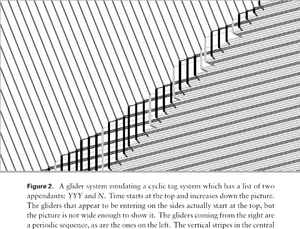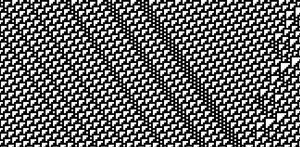User:Ssstephen/Reading/Universality in Elementary Cellular Automata: Difference between revisions
(Created page with "Because a system is universal, some of its properties are undecidable (will it become periodic, will a particular sequence occur) Because Turing machines are universal, if a compiler exists that can compile any data and program from a turing machine to another computer, then that computer is also universal Tag systems are universal ACDABBE --> DABBECCDD Cyclic tag systems can only have a two letter alphabet {Y,N}, but they can emulate tag systems so are also universal...") |
No edit summary |
||
| Line 17: | Line 17: | ||
Fabric version of this could be really interesting. If you got a round loom with 14n pins (a flat loom maybe would be more flexible, to decide different sizes), you could knit a hat or sock program. https://www.youtube.com/watch?v=gOTIAmg0Iow Or does it need to be woven? No idea. | Fabric version of this could be really interesting. If you got a round loom with 14n pins (a flat loom maybe would be more flexible, to decide different sizes), you could knit a hat or sock program. https://www.youtube.com/watch?v=gOTIAmg0Iow Or does it need to be woven? No idea. | ||
The piece should be a ring so the ends more obviously loop back on themselves. Re: slow computing, computation as labour, This Work of Body / This Body of Work, Meghan Clarke https://www.designacademy.nl/p/study-at-dae/graduation-show/graduation-projects/meghan-clarke | The piece should be a ring so the ends more obviously loop back on themselves. Re: slow computing, computation as labour, This Work of Body / This Body of Work, Meghan Clarke https://www.designacademy.nl/p/study-at-dae/graduation-show/graduation-projects/meghan-clarke Talk to Daniela about double sided knitting, re [https://youtu.be/Z0uwla1VYHQ binary knitting] and [https://youtu.be/Kr5GmHPYJrE ternary knitting]. So the knitting is the computation; knit the first line of the program then knit further to get the output. A little similar to a quipu, although probably a less efficient system. Are quipus universal? | ||
[[File:A-gliders.png|thumb|right|alt=Programming some A gliders into 110, of increasing width from left to right.|Programming some A gliders into 110, of increasing width from left to right.]] | |||
What can you compute on rule 110 (apart from everything)? Can you write a hello world script on a rule 110 computer? Can you add 2+2? https://www.youtube.com/watch?v=QKnSRw_X2w4 | What can you compute on rule 110 (apart from everything)? Can you write a hello world script on a rule 110 computer? Can you add 2+2? https://www.youtube.com/watch?v=QKnSRw_X2w4 | ||
First attempts here at coding in the p5.js version of 110 with a few A gliders of increasing widths. Even experimenting on the javascript version of this is so slow, doing this in playing cards or knitting would be incredibly slow. But if it's a statement about computational labour the slowness reveals that. | |||
Stopped at page 13 for now. | |||
Latest revision as of 19:19, 5 November 2022
Because a system is universal, some of its properties are undecidable (will it become periodic, will a particular sequence occur)
Because Turing machines are universal, if a compiler exists that can compile any data and program from a turing machine to another computer, then that computer is also universal
Tag systems are universal ACDABBE --> DABBECCDD
Cyclic tag systems can only have a two letter alphabet {Y,N}, but they can emulate tag systems so are also universal.
A glider system (see image) is a system of moving particles called gliders. In the image you can see diagonal lines which interact with vertical lines (the tape head or data) in the centre, emulating a cyclic tag system. The glider system is running an emulation of the cyclic tag system, which is running an emulation of the tag system. In a way this looks like a vector system to me, of interacting vectors rather than flipping bits.
Lastly you run an emulation of the glider system inside rule 110.
-
Fabric version of this could be really interesting. If you got a round loom with 14n pins (a flat loom maybe would be more flexible, to decide different sizes), you could knit a hat or sock program. https://www.youtube.com/watch?v=gOTIAmg0Iow Or does it need to be woven? No idea.
The piece should be a ring so the ends more obviously loop back on themselves. Re: slow computing, computation as labour, This Work of Body / This Body of Work, Meghan Clarke https://www.designacademy.nl/p/study-at-dae/graduation-show/graduation-projects/meghan-clarke Talk to Daniela about double sided knitting, re binary knitting and ternary knitting. So the knitting is the computation; knit the first line of the program then knit further to get the output. A little similar to a quipu, although probably a less efficient system. Are quipus universal?
What can you compute on rule 110 (apart from everything)? Can you write a hello world script on a rule 110 computer? Can you add 2+2? https://www.youtube.com/watch?v=QKnSRw_X2w4
First attempts here at coding in the p5.js version of 110 with a few A gliders of increasing widths. Even experimenting on the javascript version of this is so slow, doing this in playing cards or knitting would be incredibly slow. But if it's a statement about computational labour the slowness reveals that.
Stopped at page 13 for now.


